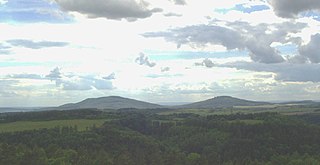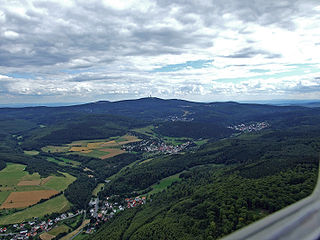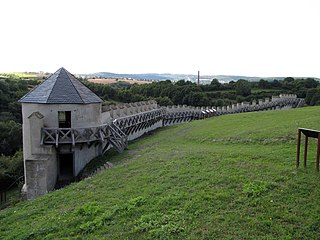
Aphaea was a Greek goddess who was worshipped almost exclusively at a single sanctuary on the island of Aegina in the Saronic Gulf. She originated as early as the 14th century BCE as a local deity associated with fertility and the agricultural cycle. Under Athenian hegemony, however, she came to be identified with the goddesses Athena and Artemis and with the nymph Britomartis as well, by the 2nd century CE, the time of Pausanias:
On Aigina as one goes toward the mountain of Zeus, god of all the Hellenes, the sanctuary of Aphaia comes up, for whom Pindar composed an ode at the behest of the Aeginetans. The Cretans say that Euboulos was the son of Kharmanor, who purified Apollo of the killing of the Python, and they say that Britomartis was the daughter of Zeus and Kharme. She enjoyed races and hunts and was particularly dear to Artemis. While fleeing from Minos, who lusted after her, she cast herself into nets cast for a catch of fish. Artemis made her a goddess, and not only the Cretans but also the Aeginetans revere her. The Aeginetans say that Britomartis showed herself to them on their island. Her epithet among the Aeginetans is Aphaia, and it is Diktynna of the Nets on Crete. Description of Greece 2.30.3

The Šar Mountains, or Sharr Mountains, form a mountain range in the Balkans that extends from Kosovo and the northwest of North Macedonia, to northeastern Albania. The mountain is colloquially called Šara and forms part of a national park in Kosovo. The section in Kosovo is a national park.

Flak towers were eight complexes of large, above-ground, anti-aircraft gun blockhouse towers constructed by Nazi Germany in the cities of Berlin (3), Hamburg (2), and Vienna (3) from 1940 onwards. Other cities that used flak towers included Stuttgart and Frankfurt. Smaller single-purpose flak towers were built at key outlying German strongpoints, such as at Angers in France, Helgoland in Germany and Trondheim, Norway.

The Circus of Maxentius is an ancient structure in Rome, Italy; it is part of a complex of buildings erected by emperor Maxentius on the Via Appia between AD 306 and 312. It is situated between the second and third miles of the Via Appia between the basilica and catacombs of San Sebastiano and the imposing late republican tomb of Caecilia Metella, which dominates the hill that rises immediately to the east of the complex. It is part of the Parco Regionale Appia Antica.

Butzbach is a town in the Wetteraukreis district in Hessen, Germany. It is located approximately 16 km south of Gießen and 35 km north of Frankfurt am Main.

Denghoog is a Neolithic passage grave dating from around 3000 BC on the northern edge of Wenningstedt-Braderup on the German island of Sylt. The name Denghoog derives from the Söl'ring Deng (Thing) and Hoog (Hill).

Żarnów is a historical village in Opoczno County, Łódź Voivodeship, in central Poland. It is the seat of the administrative district called Gmina Żarnów. It lies approximately 18 kilometres (11 mi) south-west of Opoczno and 77 km (48 mi) south-east of the regional capital Łódź. Between 1415 and 1876 the village had a status of a town.

Bílý Potok is a small village located in the foothills of Rychlebské Hory in the Olomouc Region, Czech Republic. The village still administers the nearby settlement Chlum and today is a part of the town of Javorník.

At 971 m above sea level (NN) the Wurmberg is the second highest mountain in the Harz and the highest in Lower Saxony (Germany).

The Hessian Skittles are a group of nine extinct volcanoes in the northwestern and lowest part of the Rhön Mountains in East Hesse, Germany. This striking collection of domed hills or kuppen is located in the counties of Hersfeld-Rotenburg and Fulda in the northwestern part of the Kuppen Rhön east of Eiterfeld and south of Schenklengsfeld.
Purushanda was an ancient city-state in central Anatolia, lying south of the Kızılırmak River in what is now modern Turkey. Its site has yet to be discovered. It may have been situated south-east of Lake Tuz, possibly on the mound of Acemhöyük approximately 6 kilometres (3.7 mi) north-west of the city of Aksaray. Another possible location is the mound of Karahöyük near Konya.

The Ölbergshöhe in the Harz Mountains of central Germany is a mountain spur, 320.6 m, of the Ramberg ridge near Bad Suderode in the Saxony-Anhalt county of Harz.

Novo Brdo Fortress is a medieval Serbian fortress in Kosovo. Its ruins are located near the town of Novo Brdo, about 40 kilometres (25 mi) east of Pristina. The fortress was built in the late 13th century by king Stephen Uroš II Milutin of Serbia to protect gold, silver, iron and lead mines which were abundant throughout the area. Novo Brdo was famous for its silver. Together with the castles of Prizrenac, 12 kilometres (7.5 mi) to the southwest, and Prilepac, 13 kilometres (8.1 mi) to the southeast, which guard access roads to the fortress, Novo Brdo helped form a defensive complex overlooking the lucrative mining operations. Novo Brdo was at its height during the Serbian Despotate (1402–1459), when it was the most important mining area and second most important town in Serbia. A significant number of Saxon miners and a large Ragusan merchant colony lived within the town, which was ruled by a vojvoda, but also a governor (kefalija), because it was the seat of an administrative unit of the Despotate.

The Pöstlingberg is a 539 metres (1,768 ft) high hill on the left bank of the Danube in the city of Linz, Austria. It is a popular tourist destination, with a viewing platform over the city, and is the site of the Pöstlingberg pilgrimage church, and the Linz Grottenbahn.

The Pleß is a mountain, 645.4 m above sea level (NHN), in the county of Schmalkalden-Meiningen in the Salzungen Werra Highland in the German state of Thuringia.

Hausberg is German for a prominent mountain or hill in the immediate vicinity of a village, town or city, usually located on its municipal territory, but outside the built up area. It means something like the "local mountain" or "local hill" closely associated with a settlement by its population. The Hausberg forms a backdrop to its home settlement and also offers a prominent viewing point looking over the settlement. As a result, many Hausberge have cable cars or gondola lifts to transport visitors to the top. "Hausberg" is also the proper name of numerous local mountains and hills in German-speaking countries.

Steinsburg is the colloquial name for the remains of a Celtic oppidum on the Kleiner Gleichberg in the German state of South Thuringia. It is located within the county of Hildburghausen by Waldhaus near the small town of Römhild.

The Taunus Nature Park is a nature park in Central Germany with an area of 134,775 hectares (1347.75 km²) in the Central Upland range of the Taunus. It is one of two Hessian nature parks in the Taunus and the second largest nature park in Hesse.

The Wetterau Limes is the name given in the field of historical research to that part of the Upper Germanic-Rhaetian Limes which enclosed the region that became known later as the Wetterau in the German state of Hesse.

Katzenberg Hillfort is a Roman refuge fort near Mayen in Germany dating to the 4th century.





















